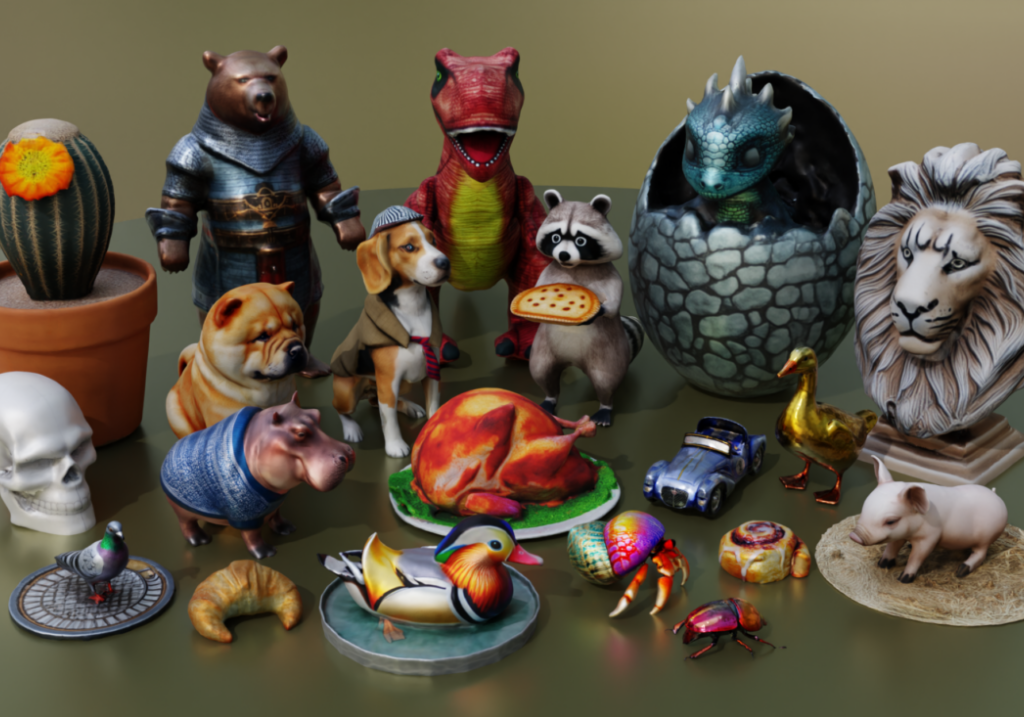Meta, formerly known as Facebook, has introduced a revolutionary AI system called “Meta 3D Gen” that is poised to transform the landscape of 3D content creation. This cutting-edge technology enables the generation of high-quality, textured 3D models in under a minute, opening up new possibilities for artists, developers, and creators across various industries.
Unveiling the Power of Meta 3D Gen
Meta 3D Gen comprises two distinct components: Meta 3D AssetGen and Meta 3D TextureGen. The AssetGen component takes text prompts as input and generates a base 3D mesh model, incorporating Physically Based Rendering (PBR) materials. This initial stage lays the foundation for a detailed 3D asset. The TextureGen component then refines the generated mesh by applying high-resolution textures and enhancing the PBR materials. This results in a final 3D model that is visually stunning and can be seamlessly integrated into existing workflows.
Key Features and Implications
- Speed and Efficiency: Meta 3D Gen’s ability to generate 3D models in less than 60 seconds marks a significant leap in efficiency. This rapid turnaround time accelerates the creative process, enabling artists and developers to iterate and experiment with ideas more freely.
- Text-to-3D Generation: The text-to-3D capability democratizes 3D content creation. Users can simply describe the desired object using text prompts, and Meta 3D Gen will translate those prompts into tangible 3D models. This eliminates the need for complex 3D modeling skills, making the technology accessible to a wider audience.
- High-Quality Output: The models generated by Meta 3D Gen boast intricate details and realistic textures, thanks to the PBR materials. This ensures that the assets can be seamlessly integrated into games, virtual reality environments, and other applications where visual fidelity is paramount.
- Customization and Control: Users can exercise a degree of control over the generated models by providing specific prompts and adjusting parameters. This allows for customization and fine-tuning of the assets to meet individual preferences and project requirements.
Potential Impact and Applications
Meta 3D Gen has the potential to disrupt several industries:
- Gaming: Game developers can leverage this technology to rapidly prototype and create in-game assets, saving time and resources during the development process.
- Virtual Reality (VR) and Augmented Reality (AR): The ability to quickly generate 3D models can facilitate the creation of immersive VR and AR experiences, where realistic environments and objects are crucial.
- E-commerce: Retailers can showcase products in 3D, offering customers a more interactive and engaging shopping experience.
- Education: Meta 3D Gen can be used to generate educational models and simulations, making complex concepts more accessible and interactive for students.
Research and Future Directions
Meta has published a research paper detailing the technical aspects of Meta 3D Gen. This research outlines the underlying algorithms and techniques used to achieve such impressive results. Additionally, Meta is actively exploring ways to further enhance the system, including expanding its capabilities to generate more complex scenes and animations.
Conclusion
Meta 3D Gen represents a major advancement in AI-driven 3D asset creation. Its combination of speed, quality, and accessibility has the potential to democratize 3D content creation and revolutionize industries that rely on 3D assets. As Meta continues to refine and expand this technology, we can expect to see even more innovative applications and use cases emerge in the near future.



